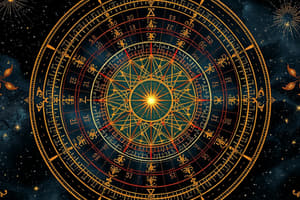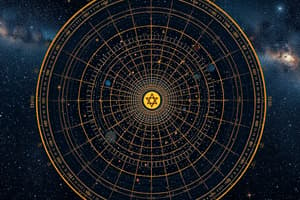Podcast
Questions and Answers
What is the primary purpose of the Hertzsprung-Russell diagram?
What is the primary purpose of the Hertzsprung-Russell diagram?
- To determine the age of stars
- To classify stars based on their spectral type
- To measure the distance to stars
- To compare the luminosity and surface temperature of stars (correct)
Which type of star is characterized as high-mass, high-luminosity, and hot?
Which type of star is characterized as high-mass, high-luminosity, and hot?
- M stars
- Red giants
- F-G-K stars
- O-B-A stars (correct)
What is the term for the vertical branch on the HR diagram where stars are fusing helium in their cores?
What is the term for the vertical branch on the HR diagram where stars are fusing helium in their cores?
- Red giant branch (correct)
- White dwarf region
- Horizontal branch
- Main sequence
What is the eventual fate of low-mass stars that have exhausted their fuel?
What is the eventual fate of low-mass stars that have exhausted their fuel?
What is the characteristic of stars on the horizontal branch of the HR diagram?
What is the characteristic of stars on the horizontal branch of the HR diagram?
Where are white dwarfs and neutron stars typically found on the HR diagram?
Where are white dwarfs and neutron stars typically found on the HR diagram?
What is the direction of the gravitational force between two objects?
What is the direction of the gravitational force between two objects?
What is the effect of increasing the distance between two objects on the gravitational force between them?
What is the effect of increasing the distance between two objects on the gravitational force between them?
What is the unit of the gravitational constant (G)?
What is the unit of the gravitational constant (G)?
What is responsible for the motion of planets, stars, and galaxies?
What is responsible for the motion of planets, stars, and galaxies?
What is the effect of increasing the mass of one of the objects on the gravitational force between two objects?
What is the effect of increasing the mass of one of the objects on the gravitational force between two objects?
What is the type of force that gravity is?
What is the type of force that gravity is?
Flashcards are hidden until you start studying
Study Notes
HR Diagram Interpretation
Understanding the HR Diagram
- The Hertzsprung-Russell (HR) diagram is a graph that plots a star's luminosity (brightness) against its surface temperature.
- It is a powerful tool for understanding the life cycles of stars.
Main Sequence
- The main sequence is the diagonal band on the HR diagram where most stars are found.
- Stars on the main sequence are fusing hydrogen into helium in their cores.
- The main sequence is divided into three categories:
- O-B-A stars: High-mass, high-luminosity, and hot.
- F-G-K stars: Medium-mass, medium-luminosity, and intermediate temperature.
- M stars: Low-mass, low-luminosity, and cool.
Post-Main Sequence
- Stars that have exhausted their hydrogen fuel and left the main sequence.
- They expand to become red giants, increasing in luminosity and cooling.
- Red giant branch: The vertical branch on the HR diagram where stars are fusing helium in their cores.
- Horizontal branch: The horizontal branch on the HR diagram where stars are fusing helium in their cores and have a constant luminosity.
White Dwarfs and Neutron Stars
- White dwarfs: The remnants of low-mass stars that have exhausted their fuel and shed their outer layers.
- Neutron stars: The remnants of high-mass stars that have undergone a supernova explosion.
- Both are found on the lower left of the HR diagram, with high surface temperatures and low luminosities.
Interpreting the HR Diagram
- The HR diagram can be used to determine a star's:
- Age
- Mass
- Composition
- Evolutionary stage
- By comparing the luminosity and temperature of a star to the HR diagram, astronomers can infer its properties and life cycle.
Understanding the HR Diagram
- The Hertzsprung-Russell (HR) diagram is a graph that plots a star's luminosity (brightness) against its surface temperature.
- It is a powerful tool for understanding the life cycles of stars.
Main Sequence
- The main sequence is the diagonal band on the HR diagram where most stars are found.
- Stars on the main sequence are fusing hydrogen into helium in their cores.
- The main sequence is divided into three categories:
- O-B-A stars: High-mass, high-luminosity, and hot.
- F-G-K stars: Medium-mass, medium-luminosity, and intermediate temperature.
- M stars: Low-mass, low-luminosity, and cool.
Post-Main Sequence
- Stars that have exhausted their hydrogen fuel and left the main sequence.
- They expand to become red giants, increasing in luminosity and cooling.
- Red giant branch: The vertical branch on the HR diagram where stars are fusing helium in their cores.
- Horizontal branch: The horizontal branch on the HR diagram where stars are fusing helium in their cores and have a constant luminosity.
White Dwarfs and Neutron Stars
- White dwarfs: The remnants of low-mass stars that have exhausted their fuel and shed their outer layers.
- Neutron stars: The remnants of high-mass stars that have undergone a supernova explosion.
- Both are found on the lower left of the HR diagram, with high surface temperatures and low luminosities.
Interpreting the HR Diagram
- The HR diagram can be used to determine a star's:
- Age
- Mass
- Composition
- Evolutionary stage
- By comparing the luminosity and temperature of a star to the HR diagram, astronomers can infer its properties and life cycle.
Gravitational Force
Definition
- Attracts two objects with mass towards each other
- Vector force with magnitude and direction
Characteristics
- Long-range force, acting over vast distances
- Weak force, but always attractive (never repulsive)
- Responsible for motion of planets, stars, and galaxies
Gravitational Force Equation
- F = G * (m1 * m2) / r^2
- G: 6.67408e-11 N m^2 kg^-2 (gravitational constant)
- m1 and m2: masses of the two objects
- r: distance between the centers of the two objects
Factors Affecting Gravitational Force
- Mass: increasing mass of either object increases the gravitational force
- Distance: increasing distance between objects decreases the gravitational force
- Gravity is independent of the medium (e.g., air, water, or vacuum)
Types of Gravitational Force
- Attraction between two objects (e.g., Earth and an object on its surface)
- Attraction between an object and a planet or moon (e.g., satellite orbiting the Earth)
- Attraction between two celestial bodies (e.g., Earth and the Sun)
Studying That Suits You
Use AI to generate personalized quizzes and flashcards to suit your learning preferences.




